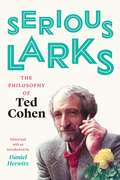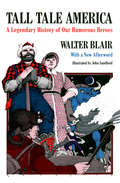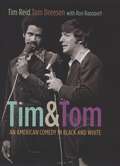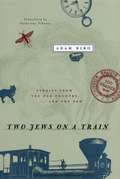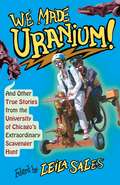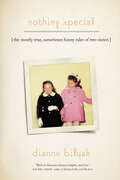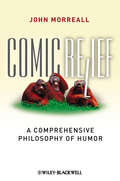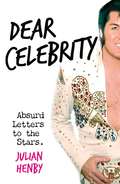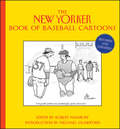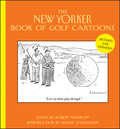- Table View
- List View
Serious Larks: The Philosophy of Ted Cohen
by Ted CohenTed Cohen was an original and captivating essayist known for his inquisitive intelligence, wit, charm, and a deeply humane feel for life. For Cohen, writing was a way of discovering, and also celebrating, the depth and complexity of things overlooked by most professional philosophers and aestheticians—but not by most people. Whether writing about the rules of baseball, of driving, or of Kant’s Third Critique; about Hitchcock, ceramics, or jokes, Cohen proved that if you study the world with a bemused but honest attentiveness, you can find something to philosophize about more or less anywhere. This collection, edited and introduced by philosopher Daniel Herwitz, brings together some of Cohen’s best work to capture the unique style that made Cohen one of the most beloved philosophers of his generation. Among the perceptive, engaging, and laugh-out-loud funny reflections on movies, sports, art, language, and life included here are Cohen’s classic papers on metaphor and his Pushcart Prize–winning essay on baseball, as well as memoir, fiction, and even poetry. Full of free-spirited inventiveness, these Serious Larks would be equally at home outside Thoreau’s cabin on the waters of Walden Pond as they are here, proving that intelligence, sensitivity, and good humor can be found in philosophical writing after all.
Serious Larks: The Philosophy of Ted Cohen
by Ted CohenTed Cohen was an original and captivating essayist known for his inquisitive intelligence, wit, charm, and a deeply humane feel for life. For Cohen, writing was a way of discovering, and also celebrating, the depth and complexity of things overlooked by most professional philosophers and aestheticians—but not by most people. Whether writing about the rules of baseball, of driving, or of Kant’s Third Critique; about Hitchcock, ceramics, or jokes, Cohen proved that if you study the world with a bemused but honest attentiveness, you can find something to philosophize about more or less anywhere. This collection, edited and introduced by philosopher Daniel Herwitz, brings together some of Cohen’s best work to capture the unique style that made Cohen one of the most beloved philosophers of his generation. Among the perceptive, engaging, and laugh-out-loud funny reflections on movies, sports, art, language, and life included here are Cohen’s classic papers on metaphor and his Pushcart Prize–winning essay on baseball, as well as memoir, fiction, and even poetry. Full of free-spirited inventiveness, these Serious Larks would be equally at home outside Thoreau’s cabin on the waters of Walden Pond as they are here, proving that intelligence, sensitivity, and good humor can be found in philosophical writing after all.
Serious Larks: The Philosophy of Ted Cohen
by Ted CohenTed Cohen was an original and captivating essayist known for his inquisitive intelligence, wit, charm, and a deeply humane feel for life. For Cohen, writing was a way of discovering, and also celebrating, the depth and complexity of things overlooked by most professional philosophers and aestheticians—but not by most people. Whether writing about the rules of baseball, of driving, or of Kant’s Third Critique; about Hitchcock, ceramics, or jokes, Cohen proved that if you study the world with a bemused but honest attentiveness, you can find something to philosophize about more or less anywhere. This collection, edited and introduced by philosopher Daniel Herwitz, brings together some of Cohen’s best work to capture the unique style that made Cohen one of the most beloved philosophers of his generation. Among the perceptive, engaging, and laugh-out-loud funny reflections on movies, sports, art, language, and life included here are Cohen’s classic papers on metaphor and his Pushcart Prize–winning essay on baseball, as well as memoir, fiction, and even poetry. Full of free-spirited inventiveness, these Serious Larks would be equally at home outside Thoreau’s cabin on the waters of Walden Pond as they are here, proving that intelligence, sensitivity, and good humor can be found in philosophical writing after all.
Serious Larks: The Philosophy of Ted Cohen
by Ted CohenTed Cohen was an original and captivating essayist known for his inquisitive intelligence, wit, charm, and a deeply humane feel for life. For Cohen, writing was a way of discovering, and also celebrating, the depth and complexity of things overlooked by most professional philosophers and aestheticians—but not by most people. Whether writing about the rules of baseball, of driving, or of Kant’s Third Critique; about Hitchcock, ceramics, or jokes, Cohen proved that if you study the world with a bemused but honest attentiveness, you can find something to philosophize about more or less anywhere. This collection, edited and introduced by philosopher Daniel Herwitz, brings together some of Cohen’s best work to capture the unique style that made Cohen one of the most beloved philosophers of his generation. Among the perceptive, engaging, and laugh-out-loud funny reflections on movies, sports, art, language, and life included here are Cohen’s classic papers on metaphor and his Pushcart Prize–winning essay on baseball, as well as memoir, fiction, and even poetry. Full of free-spirited inventiveness, these Serious Larks would be equally at home outside Thoreau’s cabin on the waters of Walden Pond as they are here, proving that intelligence, sensitivity, and good humor can be found in philosophical writing after all.
Serious Larks: The Philosophy of Ted Cohen
by Ted CohenTed Cohen was an original and captivating essayist known for his inquisitive intelligence, wit, charm, and a deeply humane feel for life. For Cohen, writing was a way of discovering, and also celebrating, the depth and complexity of things overlooked by most professional philosophers and aestheticians—but not by most people. Whether writing about the rules of baseball, of driving, or of Kant’s Third Critique; about Hitchcock, ceramics, or jokes, Cohen proved that if you study the world with a bemused but honest attentiveness, you can find something to philosophize about more or less anywhere. This collection, edited and introduced by philosopher Daniel Herwitz, brings together some of Cohen’s best work to capture the unique style that made Cohen one of the most beloved philosophers of his generation. Among the perceptive, engaging, and laugh-out-loud funny reflections on movies, sports, art, language, and life included here are Cohen’s classic papers on metaphor and his Pushcart Prize–winning essay on baseball, as well as memoir, fiction, and even poetry. Full of free-spirited inventiveness, these Serious Larks would be equally at home outside Thoreau’s cabin on the waters of Walden Pond as they are here, proving that intelligence, sensitivity, and good humor can be found in philosophical writing after all.
The Stray Shopping Carts of Eastern North America: A Guide to Field Identification
by Julian MontagueA taxonomy we didn’t know we needed for identifying and cataloging stray shopping carts by artist and photographer Julian Montague. Abandoned shopping carts are everywhere, and yet we know so little about them. Where do they come from? Why are they there? Their complexity and history baffle even the most careful urban explorer. Thankfully, artist Julian Montague has created a comprehensive and well-documented taxonomy with The Stray Shopping Carts of Eastern North America. Spanning thirty-three categories from damaged, fragment, and plow crush to plaza drift and bus stop discard, it is a tonic for times defined increasingly by rhetoric and media and less by the plain objects and facts of the real world. Montague’s incomparable documentation of this common feature of the urban landscape helps us see the natural and man-made worlds—and perhaps even ourselves—anew. First published in 2006 to great perplexity and acclaim alike, Montague’s book now appears in refreshed and expanded form. Told in an exceedingly dry voice, with full-color illustrations and photographs throughout, it is both rigorous and absurd, offering a strangely compelling vision of how we approach, classify, and understand the environments around us. A new afterword sheds light on the origins of the project.
The Stray Shopping Carts of Eastern North America: A Guide to Field Identification
by Julian MontagueA taxonomy we didn’t know we needed for identifying and cataloging stray shopping carts by artist and photographer Julian Montague. Abandoned shopping carts are everywhere, and yet we know so little about them. Where do they come from? Why are they there? Their complexity and history baffle even the most careful urban explorer. Thankfully, artist Julian Montague has created a comprehensive and well-documented taxonomy with The Stray Shopping Carts of Eastern North America. Spanning thirty-three categories from damaged, fragment, and plow crush to plaza drift and bus stop discard, it is a tonic for times defined increasingly by rhetoric and media and less by the plain objects and facts of the real world. Montague’s incomparable documentation of this common feature of the urban landscape helps us see the natural and man-made worlds—and perhaps even ourselves—anew. First published in 2006 to great perplexity and acclaim alike, Montague’s book now appears in refreshed and expanded form. Told in an exceedingly dry voice, with full-color illustrations and photographs throughout, it is both rigorous and absurd, offering a strangely compelling vision of how we approach, classify, and understand the environments around us. A new afterword sheds light on the origins of the project.
Tall Tale America: A Legendary History of our Humorous Heroes
by Walter Blair"Johnny Appleseed, Davy Crockett, Pecos Bill, Paul Bunyan and John Henry have all become heroes of American folklore. Some of them, like Crokett, were real, but all have become the subject of tall tales. This is a folksy history of the United States, told as if the characters were all real. This panoramic (if completely untrue) history begins with Columbus. . . . En route to its end in the 1940s (where traditional American heroes are enlisted to fight in World War II), it covers the great and small events of our national history, including the overlooked, but important ones, such as the invention of the prairie dog."—Washington Post Book World
Tall Tale America: A Legendary History of our Humorous Heroes
by Walter Blair"Johnny Appleseed, Davy Crockett, Pecos Bill, Paul Bunyan and John Henry have all become heroes of American folklore. Some of them, like Crokett, were real, but all have become the subject of tall tales. This is a folksy history of the United States, told as if the characters were all real. This panoramic (if completely untrue) history begins with Columbus. . . . En route to its end in the 1940s (where traditional American heroes are enlisted to fight in World War II), it covers the great and small events of our national history, including the overlooked, but important ones, such as the invention of the prairie dog."—Washington Post Book World
Tim and Tom: An American Comedy in Black and White (Religion And Postmodernism Ser.)
by Tim Reid Tom Dreesen Ron RapoportAs the heady promise of the 1960s sagged under the weight of widespread violence, rioting, and racial unrest, two young men--one black and one white--took to stages across the nation to help Americans confront their racial divide: by laughing at it. Tim and Tom tells the story of that pioneering duo, the first interracial comedy team in the history of show business--and the last. Tim Reid and Tom Dreesen polished their act in the nightclubs of Chicago, then took it on the road, not only in the North, but in the still-simmering South as well, developing routines that even today remain surprisingly frank--and remarkably funny--about race. Most nights, the shock of seeing an integrated comedy team quickly dissipated in uproarious laughter, but on some occasions the audience’s confusion and discomfort led to racist heckling, threats, and even violence. Though Tim and Tom perpetually seemed on the verge of making it big throughout their five years together, they grudgingly came to realize that they were ahead of their time: America was not yet ready to laugh at its own failed promise. Eventually, the grind of the road took its toll, as bitter arguments led to an acrimonious breakup. But the underlying bond of friendship Reid and Dreesen had forged with each groundbreaking joke has endured for decades, while their solo careers delivered the success that had eluded them as a team. By turns revealing, shocking, and riotously funny, Tim and Tom unearths a largely forgotten chapter in the history of comedy.
Tim and Tom: An American Comedy in Black and White (None Ser.)
by Tim Reid Tom Dreesen Ron RapoportAs the heady promise of the 1960s sagged under the weight of widespread violence, rioting, and racial unrest, two young men--one black and one white--took to stages across the nation to help Americans confront their racial divide: by laughing at it. Tim and Tom tells the story of that pioneering duo, the first interracial comedy team in the history of show business--and the last. Tim Reid and Tom Dreesen polished their act in the nightclubs of Chicago, then took it on the road, not only in the North, but in the still-simmering South as well, developing routines that even today remain surprisingly frank--and remarkably funny--about race. Most nights, the shock of seeing an integrated comedy team quickly dissipated in uproarious laughter, but on some occasions the audience’s confusion and discomfort led to racist heckling, threats, and even violence. Though Tim and Tom perpetually seemed on the verge of making it big throughout their five years together, they grudgingly came to realize that they were ahead of their time: America was not yet ready to laugh at its own failed promise. Eventually, the grind of the road took its toll, as bitter arguments led to an acrimonious breakup. But the underlying bond of friendship Reid and Dreesen had forged with each groundbreaking joke has endured for decades, while their solo careers delivered the success that had eluded them as a team. By turns revealing, shocking, and riotously funny, Tim and Tom unearths a largely forgotten chapter in the history of comedy.
Tim and Tom: An American Comedy in Black and White (Religion And Postmodernism Ser.)
by Tim Reid Tom Dreesen Ron RapoportAs the heady promise of the 1960s sagged under the weight of widespread violence, rioting, and racial unrest, two young men--one black and one white--took to stages across the nation to help Americans confront their racial divide: by laughing at it. Tim and Tom tells the story of that pioneering duo, the first interracial comedy team in the history of show business--and the last. Tim Reid and Tom Dreesen polished their act in the nightclubs of Chicago, then took it on the road, not only in the North, but in the still-simmering South as well, developing routines that even today remain surprisingly frank--and remarkably funny--about race. Most nights, the shock of seeing an integrated comedy team quickly dissipated in uproarious laughter, but on some occasions the audience’s confusion and discomfort led to racist heckling, threats, and even violence. Though Tim and Tom perpetually seemed on the verge of making it big throughout their five years together, they grudgingly came to realize that they were ahead of their time: America was not yet ready to laugh at its own failed promise. Eventually, the grind of the road took its toll, as bitter arguments led to an acrimonious breakup. But the underlying bond of friendship Reid and Dreesen had forged with each groundbreaking joke has endured for decades, while their solo careers delivered the success that had eluded them as a team. By turns revealing, shocking, and riotously funny, Tim and Tom unearths a largely forgotten chapter in the history of comedy.
Tim and Tom: An American Comedy in Black and White (None Ser.)
by Tim Reid Tom Dreesen Ron RapoportAs the heady promise of the 1960s sagged under the weight of widespread violence, rioting, and racial unrest, two young men--one black and one white--took to stages across the nation to help Americans confront their racial divide: by laughing at it. Tim and Tom tells the story of that pioneering duo, the first interracial comedy team in the history of show business--and the last. Tim Reid and Tom Dreesen polished their act in the nightclubs of Chicago, then took it on the road, not only in the North, but in the still-simmering South as well, developing routines that even today remain surprisingly frank--and remarkably funny--about race. Most nights, the shock of seeing an integrated comedy team quickly dissipated in uproarious laughter, but on some occasions the audience’s confusion and discomfort led to racist heckling, threats, and even violence. Though Tim and Tom perpetually seemed on the verge of making it big throughout their five years together, they grudgingly came to realize that they were ahead of their time: America was not yet ready to laugh at its own failed promise. Eventually, the grind of the road took its toll, as bitter arguments led to an acrimonious breakup. But the underlying bond of friendship Reid and Dreesen had forged with each groundbreaking joke has endured for decades, while their solo careers delivered the success that had eluded them as a team. By turns revealing, shocking, and riotously funny, Tim and Tom unearths a largely forgotten chapter in the history of comedy.
Two Jews on a Train: Stories from the Old Country and the New
by Adam Biro"Two Jews were traveling on a train. . . . " Many Eastern European jokes—and several of the charming and often hilarious conversations in this book—begin this way. From all regions of the world and from all walks of life, the characters are young and full of life and old and ugly; they are rabbis, matchmakers, students, and immigrants. They gossip and speak about everything from the banalities of the world to the unspeakable evils of existence all for a single purpose: to laugh and to celebrate the good luck of being alive. As Biro recounts these tales, we hear not only his voice and the voice of his father, but those of generations of storytellers who have used humor to teach about the truly important issues in life—the delicacy of love, the fragility of friendship, the pitfalls of self-righteousness, the costs of narrow-mindedness, and the unpredictability of life itself. Biro artfully spins each story, lingering on the details, guiding the reader to the inevitable—yet always unexpected—punchline. Taken individually, these stories will make you laugh out loud; taken as a whole, they form an invaluable record of the sensibilities of an entire people. Biro writes: "These Jewish stories of which not a single one happened to me, and of which I did not invent a single one, do describe me, do characterize me, do explain me. They are always my own story. And yours."
We Made Uranium!: And Other True Stories from the University of Chicago's Extraordinary Scavenger Hunt
by Leila SalesItem #176: A fire drill. No, not an exercise in which occupants of a building practice leaving the building safely. A drill which safely emits a bit of fire, the approximate shape and size of a drill bit. Item #74: Enter a lecture class in street clothes. Receive loud phone call. Shout “I NEED TO GO, THE CITY NEEDS ME!” Remove street clothes to reveal superhero apparel. Run out for the good of the land. Item #293: Hypnotizing a chicken seems easy, but if the Wikipedia article on the practice is to be believed, debate on the optimal method is heated. Do some trials on a real chicken and submit a report . . . for science of course. Item #234: A walking, working, people-powered but preferably wind-powered Strandbeest. Item #188: Fattest cat. Points per pound. The University of Chicago’s annual Scavenger Hunt (or “Scav”) is one of the most storied college traditions in America. Every year, teams of hundreds of competitors scramble over four days to complete roughly 350 challenges. The tasks range from moments of silliness to 1,000-mile road trips, and they call on participants to fully embrace the absurd. For students it is a rite of passage, and for the surrounding community it is a chance to glimpse the lighter side of a notoriously serious university. We Made Uranium! shares the stories behind Scav, told by participants and judges from the hunt’s more than thirty-year history. The twenty-three essays range from the shockingly successful (a genuine, if minuscule, nuclear reaction created in a dorm room) to the endearing failures (it’s hard to build a carwash for a train), and all the chicken hypnotisms and permanent tattoos in between. Taken together, they show how a scavenger hunt once meant for blowing off steam before finals has grown into one of the most outrageous annual traditions at any university. The tales told here are absurd, uplifting, hilarious, and thought-provoking—and they are all one hundred percent true.
We Made Uranium!: And Other True Stories from the University of Chicago's Extraordinary Scavenger Hunt
by Leila SalesItem #176: A fire drill. No, not an exercise in which occupants of a building practice leaving the building safely. A drill which safely emits a bit of fire, the approximate shape and size of a drill bit. Item #74: Enter a lecture class in street clothes. Receive loud phone call. Shout “I NEED TO GO, THE CITY NEEDS ME!” Remove street clothes to reveal superhero apparel. Run out for the good of the land. Item #293: Hypnotizing a chicken seems easy, but if the Wikipedia article on the practice is to be believed, debate on the optimal method is heated. Do some trials on a real chicken and submit a report . . . for science of course. Item #234: A walking, working, people-powered but preferably wind-powered Strandbeest. Item #188: Fattest cat. Points per pound. The University of Chicago’s annual Scavenger Hunt (or “Scav”) is one of the most storied college traditions in America. Every year, teams of hundreds of competitors scramble over four days to complete roughly 350 challenges. The tasks range from moments of silliness to 1,000-mile road trips, and they call on participants to fully embrace the absurd. For students it is a rite of passage, and for the surrounding community it is a chance to glimpse the lighter side of a notoriously serious university. We Made Uranium! shares the stories behind Scav, told by participants and judges from the hunt’s more than thirty-year history. The twenty-three essays range from the shockingly successful (a genuine, if minuscule, nuclear reaction created in a dorm room) to the endearing failures (it’s hard to build a carwash for a train), and all the chicken hypnotisms and permanent tattoos in between. Taken together, they show how a scavenger hunt once meant for blowing off steam before finals has grown into one of the most outrageous annual traditions at any university. The tales told here are absurd, uplifting, hilarious, and thought-provoking—and they are all one hundred percent true.
We Made Uranium!: And Other True Stories from the University of Chicago's Extraordinary Scavenger Hunt
by Leila SalesItem #176: A fire drill. No, not an exercise in which occupants of a building practice leaving the building safely. A drill which safely emits a bit of fire, the approximate shape and size of a drill bit. Item #74: Enter a lecture class in street clothes. Receive loud phone call. Shout “I NEED TO GO, THE CITY NEEDS ME!” Remove street clothes to reveal superhero apparel. Run out for the good of the land. Item #293: Hypnotizing a chicken seems easy, but if the Wikipedia article on the practice is to be believed, debate on the optimal method is heated. Do some trials on a real chicken and submit a report . . . for science of course. Item #234: A walking, working, people-powered but preferably wind-powered Strandbeest. Item #188: Fattest cat. Points per pound. The University of Chicago’s annual Scavenger Hunt (or “Scav”) is one of the most storied college traditions in America. Every year, teams of hundreds of competitors scramble over four days to complete roughly 350 challenges. The tasks range from moments of silliness to 1,000-mile road trips, and they call on participants to fully embrace the absurd. For students it is a rite of passage, and for the surrounding community it is a chance to glimpse the lighter side of a notoriously serious university. We Made Uranium! shares the stories behind Scav, told by participants and judges from the hunt’s more than thirty-year history. The twenty-three essays range from the shockingly successful (a genuine, if minuscule, nuclear reaction created in a dorm room) to the endearing failures (it’s hard to build a carwash for a train), and all the chicken hypnotisms and permanent tattoos in between. Taken together, they show how a scavenger hunt once meant for blowing off steam before finals has grown into one of the most outrageous annual traditions at any university. The tales told here are absurd, uplifting, hilarious, and thought-provoking—and they are all one hundred percent true.
We Made Uranium!: And Other True Stories from the University of Chicago's Extraordinary Scavenger Hunt
Item #176: A fire drill. No, not an exercise in which occupants of a building practice leaving the building safely. A drill which safely emits a bit of fire, the approximate shape and size of a drill bit. Item #74: Enter a lecture class in street clothes. Receive loud phone call. Shout “I NEED TO GO, THE CITY NEEDS ME!” Remove street clothes to reveal superhero apparel. Run out for the good of the land. Item #293: Hypnotizing a chicken seems easy, but if the Wikipedia article on the practice is to be believed, debate on the optimal method is heated. Do some trials on a real chicken and submit a report . . . for science of course. Item #234: A walking, working, people-powered but preferably wind-powered Strandbeest. Item #188: Fattest cat. Points per pound. The University of Chicago’s annual Scavenger Hunt (or “Scav”) is one of the most storied college traditions in America. Every year, teams of hundreds of competitors scramble over four days to complete roughly 350 challenges. The tasks range from moments of silliness to 1,000-mile road trips, and they call on participants to fully embrace the absurd. For students it is a rite of passage, and for the surrounding community it is a chance to glimpse the lighter side of a notoriously serious university. We Made Uranium! shares the stories behind Scav, told by participants and judges from the hunt’s more than thirty-year history. The twenty-three essays range from the shockingly successful (a genuine, if minuscule, nuclear reaction created in a dorm room) to the endearing failures (it’s hard to build a carwash for a train), and all the chicken hypnotisms and permanent tattoos in between. Taken together, they show how a scavenger hunt once meant for blowing off steam before finals has grown into one of the most outrageous annual traditions at any university. The tales told here are absurd, uplifting, hilarious, and thought-provoking—and they are all one hundred percent true.
Nothing Special: The Mostly True, Sometimes Funny Tales of Two Sisters (The Driftless Series)
by Dianne BilyakNothing Special is a disarmingly candid tale of two sisters growing up in the 1970s in rural Connecticut. Older sister Chris, who has Down syndrome, is an extrovert with a knack for getting what she wants, while the author, her younger, typically developing sister shoulders the burdens and grief of her parents, especially their father's alcoholism. In Nothing Special Bilyak details wrestling with their mixed emotions in vignettes that range from heartrending to laugh-out-loud funny, including anecdotes about Chris's habit of faux smoking popsicle sticks or partying through the night with her invisible friends. Poet and disability advocate Dianne Bilyak strikes a rare balance between poignant and hilarious as she paints a compassionate and critical real-world picture of their lives. They struggle, separately and together, with the tension between dependence and independence, the complexities of giving versus receiving, the pressure to live as others expect, and in the end, the wonderful liberation of self-acceptance.
Comic Relief: A Comprehensive Philosophy of Humor (New Directions in Aesthetics #27)
by John MorreallComic Relief: A Comprehensive Philosophy of Humor develops an inclusive theory that integrates psychological, aesthetic, and ethical issues relating to humor Offers an enlightening and accessible foray into the serious business of humor Reveals how standard theories of humor fail to explain its true nature and actually support traditional prejudices against humor as being antisocial, irrational, and foolish Argues that humor’s benefits overlap significantly with those of philosophy Includes a foreword by Robert Mankoff, Cartoon Editor of The New Yorker
Comic Relief: A Comprehensive Philosophy of Humor (New Directions in Aesthetics)
by John MorreallComic Relief: A Comprehensive Philosophy of Humor develops an inclusive theory that integrates psychological, aesthetic, and ethical issues relating to humor Offers an enlightening and accessible foray into the serious business of humor Reveals how standard theories of humor fail to explain its true nature and actually support traditional prejudices against humor as being antisocial, irrational, and foolish Argues that humor’s benefits overlap significantly with those of philosophy Includes a foreword by Robert Mankoff, Cartoon Editor of The New Yorker
Dear Celebrity: Absurd Letters to the Stars
by Julian HenbyWelcome to the weird and wonderful world of Julian Henby. For some time now, Julian, the Bridget Jones of letter writing, has been badgering decent, hard-working celebrities with a barrage of frankly absurd correspondence, often relating to his dysfunctional family and pets. Dear Celebrity is a compilation of some of his finest work and includes many of the best celebrity responses. So, can Matthew Kelly find Henby's mother a job as a Bearded Lady? Will Professor Lord Robert Winston be able to do anything to help Julian's hamster, David, whose locomotion is severely impaired by his erection which drags along the floor like a fifth leg? Will Joanna Lumley find the time to visit Julian's elderly uncle to talk about her career? And why does Sir Jimmy Savile insist on being the Loch Ness monster? The answers to these and many more questions are to be found here...
The New Yorker Book of Baseball Cartoons (New Yorker #93)
by Robert Mankoff Michael CrawfordA loving look at the old ball game, from the cartoonists at The New Yorker America's national pastime engages fans and fanatics across the country and around the world. Across the magazine's eight decades, the artists at The New Yorker have captured the emotional essence of the game, and The New Yorker Book of Baseball Cartoons, Second Edition brings an all-star lineup of cartooning greats together in one delightful collection. Collects over 100 drawings that present a playful view of the all-American sport Includes an introduction by Michael Crawford Features classic cartoons by New Yorker legends from Charles Addams to Jack Ziegler Selected by Robert Mankoff, acclaimed cartoonist and cartoon editor of The New Yorker, The New Yorker Book of Baseball Cartoons is a home run for baseball fans of all ages.
The New Yorker Book of Baseball Cartoons (New Yorker #87)
by Robert Mankoff Michael CrawfordA loving look at the old ball game, from the cartoonists at The New Yorker America's national pastime engages fans and fanatics across the country and around the world. Across the magazine's eight decades, the artists at The New Yorker have captured the emotional essence of the game, and The New Yorker Book of Baseball Cartoons, Second Edition brings an all-star lineup of cartooning greats together in one delightful collection. Collects over 100 drawings that present a playful view of the all-American sport Includes an introduction by Michael Crawford Features classic cartoons by New Yorker legends from Charles Addams to Jack Ziegler Selected by Robert Mankoff, acclaimed cartoonist and cartoon editor of The New Yorker, The New Yorker Book of Baseball Cartoons is a home run for baseball fans of all ages.
The New Yorker Book of Golf Cartoons (New Yorker #94)
by Robert Mankoff Danny ShanahanA wry look at the golfing world, from the beloved cartoonists at The New Yorker A hilarious hole-in-one for golfers and cartoon-lovers alike, The New Yorker Book of Golf Cartoons, Second Edition brings together over a hundred classic images from across the magazine's eighty-plus-year history. Edited by Robert Mankoff, acclaimed cartoonist and cartoon editor at The New Yorker, and featuring work from legendary artists including Charles Addams, Roz Chast, Whitney Darrow Jr., Edward Koren, George Price, William Steig, and many others, the book is a side-splitting tribute to the game. Brings together over 100 golf-related cartoons by the best-loved cartoonists at The New Yorker Edited by the cartoonist and New Yorker cartoon editor Robert Mankoff Newly revised and updated to include coverage of the most recent developments in the golfing world, including Tiger Woods's troubles and more Features an introduction by Danny Shanahan A timeless anthology of the very best golf cartoons ever to grace the pages of America's favorite magazine, The New Yorker Book of Golf Cartoons captures the passion and the pain of the game.
